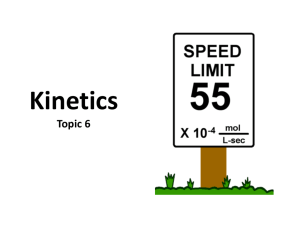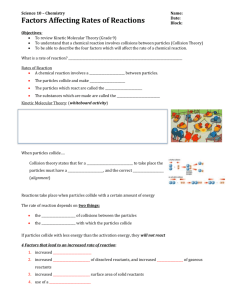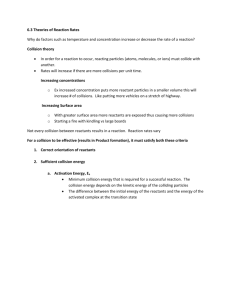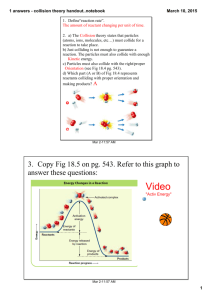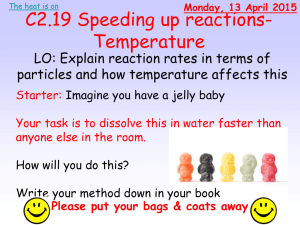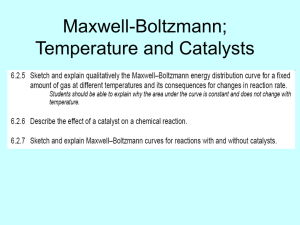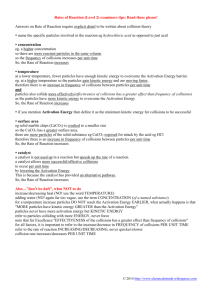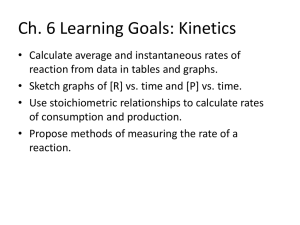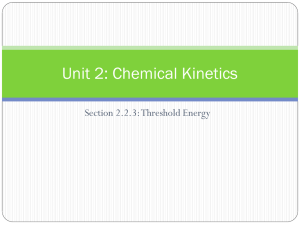Kinetics. Topic 6
advertisement
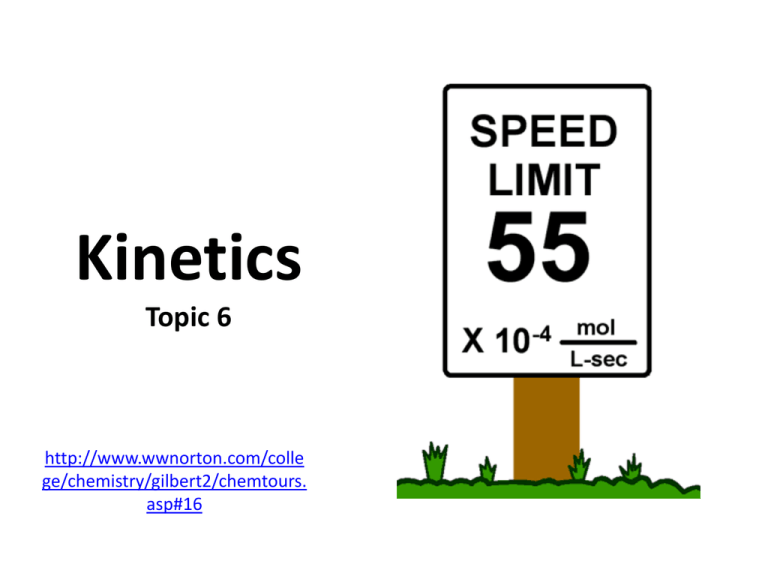
Kinetics Topic 6 http://www.wwnorton.com/colle ge/chemistry/gilbert2/chemtours. asp#16 • Rate of reactions – can be fast- explosions – can be slow- rusting – as a reaction takes place • concentration of reactants decreases (negative) over time • concentration of products increase (positive) over time – normally measure in Molarity per sec (M/s) – will continue until reaches equilibrium or one of the reactants is used up Measuring rate of reactions – can measure: • mass or volume change for gaseous reactions – mass would go down as gas escapes – volume would increase at constant temp. and pressure – pressure would increase at constant temp. and volume • change in pH if acids and bases are involved • change in electrical conductivity – if produces ions in solution, conductivity will increase • using a spectrometer to detect color changes Determining Rate of Reaction from reactions (CONCENTRATION, VOLUME, and MASS) • usually involves a graph of properties over time • usually a curve, and the reaction rate is determined from the slope of the line at a time (also known as a tangent) • reaction rates tend to slow with time as reactants are converted to products Example C4H9Cl(aq) + H2O(l) C4H9OH(aq) + HCl(aq) • reaction slows down with time because the CONCENTRATION of the reactants decreases • “rise over run” – .040M/200s = .0002M/s – .025M/400s = .000063M/s • the change in concentration of a reactant or product per unit of time • [ ] refer to the concentration of the reactants Rate [ A ] at time t 2 [ A ] at time t1 t 2 t1 Rate [ A] t 2NO2(g) 2NO(g) + O2(g) product [NO2] t [ N O2 ] t product reactant constant reaction is creating gas so gas is being released in the VOLUME increases over reaction so MASS decreases over time time • Kinetic theory (6.2.1) – energy of particles is proportional to the temperature (Kelvin or Celsius) • all particles have same energy if the same temperature • lighter particles would have greater speed than larger particles given the same energy – 𝐾𝐸 = 1/2𝑚𝑣2 Activation Energy Ea. • a minimum amount of energy required for reaction to occur – bonds need to be broken first • the molecules must posses sufficient energy to get over the activation energy barrier. Collision theory (Topic 6.2) • in order for particles to react – particles must collide – must collide in the correct orientation/angle – must collide with enough kinetic energy to overcome the activation energy (Ea) • if the previous conditions are “enough”, particles can overcome the activation energy and reaction will occur – meaning the bonds holding the reactants together will be broken http://phet.colorado.edu/en/simulation/reac tions-and-rates Factors That Affect Reaction Rates • any factor that increases the frequency of collisions or increases the energy with which particles collide will make the reaction go faster: 1. 2. 3. 4. 5. temperature pressure surface area concentration catalysts 1. Temperature • increase temp – increases number of collision per unit time • reaction rate approximately doubles for each 10oC or K rise in temperature – increases energy of the collisions 2. Pressure • only for gasses – reducing volume while keeping temp constant • forcing them together will increase number of collisions 3. Surface area • smaller particles have more surface area – only the particles on the surface can come in contact with a reactant – more collisions per unit time 4. Concentration • increasing concentration will increase more collisions per unit time 5. Catalysts • lowers the activation energy (Ea) for the reaction • provide an alternate reaction (rxn) pathway • increase the rate of a reaction • are not used up or chemically changed in the reaction Maxwell–Boltzman energy distribution curve • another way to look at what particles can react • area under the curve shows the number of gas particles • not all gas particles have the same energy – only some gas particles (blue area) have enough energy to react The affect of temperature • the area under the curve remains the same because the number of particles doesn't change • higher temps. shifts the curve to the right (therefore, the peek must be lower) resulting in an increase in collision frequency and thus more successful collisions The affect of a catalyst Never move the new activation energy to the left of the peak. Catalysts don’t help out that much!
